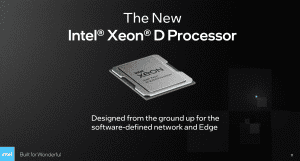News und Artikel durchsuchen
{{#data.error.root_cause}}
{{/data.error}}
{{^data.error}}
{{#texts.summary}}
[{{{type}}}] {{{reason}}}
{{/data.error.root_cause}}{{texts.summary}} {{#options.result.rssIcon}} RSS {{/options.result.rssIcon}}
{{/texts.summary}} {{#data.hits.hits}}
{{#_source.featured}}
FEATURED
{{/_source.featured}}
{{#_source.showImage}}
{{#_source.image}}
{{/_source.image}}
{{/_source.showImage}}
{{/data.hits.hits}}
{{{_source.title}}} {{#_source.showPrice}} {{{_source.displayPrice}}} {{/_source.showPrice}}
{{#_source.showLink}} {{/_source.showLink}} {{#_source.showDate}}{{{_source.displayDate}}}
{{/_source.showDate}}{{{_source.description}}}
{{#_source.additionalInfo}}{{#_source.additionalFields}} {{#title}} {{{label}}}: {{{title}}} {{/title}} {{/_source.additionalFields}}
{{/_source.additionalInfo}}
Xeon D-2700
-
Neue Xeon D-1700 und D-2700 setzen auf Ice-Lake-Kerne
 Zum Mobile World Congress stellt Intel die neuen Xeon-D-Prozessoren vor. Die Xeon-D-1700- und Xeon-D-2700-Serie ersetzt die Vorgänger auf Basis von Hewitt Lake, die noch Skylake-Kerne verwendete. Wer nun glaubt, dass Intel mit der neuen Generation auf die aktuellen Willow-Cove-Kerne setzt, den müssen wir leider enttäuschen. Als Xeon D-1700 setzen die neuen Prozessoren auf 4 bis 10 und als Xeon D-2700 auf 4 bis 20 Kerne –... [mehr]
Zum Mobile World Congress stellt Intel die neuen Xeon-D-Prozessoren vor. Die Xeon-D-1700- und Xeon-D-2700-Serie ersetzt die Vorgänger auf Basis von Hewitt Lake, die noch Skylake-Kerne verwendete. Wer nun glaubt, dass Intel mit der neuen Generation auf die aktuellen Willow-Cove-Kerne setzt, den müssen wir leider enttäuschen. Als Xeon D-1700 setzen die neuen Prozessoren auf 4 bis 10 und als Xeon D-2700 auf 4 bis 20 Kerne –... [mehr]
